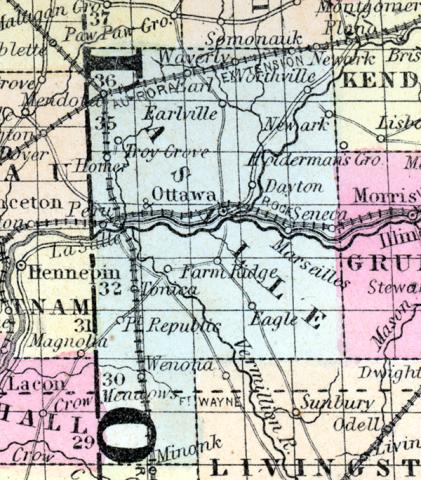PERU The city of Peru is situated in La Salle county, at the head of navigation on the Illinois river, 16 miles from Ottawa, the county seat, 114 miles from Springfield, 99 miles from Chicago, one mile from the junction of the Illinois Central railroad with the Illinois and Michigan canal, and on the Chicago and Rock Island railroad. It received its charter as a city in 1851, at which time it only numbered 1,500 inhabitants, but the superior advantages offered for manufacturing, and its commercial location, has drawn the attention of capitalists to it, and made it one of the most prominent in the State. The amount of steam shipping owned here amounts to 4,700 tons, and the whole number of arrivals, during the year 1867, were 291. The receipts of lumber by canal and railroad amounted to upward of 10,000,000 feet, while the exports were 337,000 bushels of wheat, 625,000 bushels of corn, 161,000 bushels of oats, 48,000 barrels of flour (manufactured here), 28,500 bushels of potatoes, 31,000 bushels of barley, 12,000 barrels of malt liquors, 7,000 hides, besides large quantities of beef, pork, etc., of which no accurate amount can be given. The principal article of export, however, is coal, immense quantities of which is annually shipped to the various manufacturing cities of the West, affording a revenue which, judging from present appearances, must be lasting. The Peru Coal Mining Company, the largest in the city, is capable of turning out 400 tons daily. This coal is chiefly used for manufacturing purposes, for which it is admirably adapted. Many of the Western cities are lighted with gas made from it, among which we may name Springfield, Galena, and Dubuque, Iowa.
The manufacturing interests of Peru are well developed, and consist in part of a plow factory, a fanning mill and corn sheller factory, three large breweries, one large steam flouring mill, one match factory, one foundry and machine shop, two soap and candle factories, one rectifying establishment, four saddle and harness factories, three wagon factories, four extensive brick manufactories, two lime kilns, two large furniture factories, doing a business of $276,000 annually, ten blacksmith shops, one saw and planing mill, an extensive shipyard, dry dock and marine railway, for the repairing of steamboats and barges. Considerable trade is done in ice, 16,000 tons of which is shipped annually to southern ports.
In educational advantages Peru is not behind other cities of the west, having a high school (250 students), a German and English private school, and five district schools. There are also six churches, viz.: one Episcopal, one Congregational, two Methodist, one Lutheran, and one Catholic, all fine buildings, and adding much to the beauty of the city. Besides the above there are three weekly papers published here; a bank, three hotels, and other buildings of a public and private character.' The Chambery House was built at an expense of $25,000, and is the finest in the city.
The location of the city is very fine, occupying as it does a range of table land stretching along the margin of the river, where the principal manufacturing interests are located. The climate is healthy, and scenery delightful. Separated as Peru is from La Salle by only an imaginary line, the interests of the two cities would seem to indicate an advantage were they united. In such an event a city would be formed which would be one of immense importance to the whole west—the immense coal fields by which they are underlaid being sufficient to supply an unlimited range of country, with small expense and ready dispatch. Population, 4,200. E. Winslow, Postmaster. (Hawes' Illinois State Gazetteer...,1859)
Annotations
Total Population 1850
1279
Total Population 1860
3139
Latitude
41.357906
Longitude
-89.139136
Waterways
Yes
Railroads
Yes
Type
City or Town
County
LaSalle
State
Illinois

